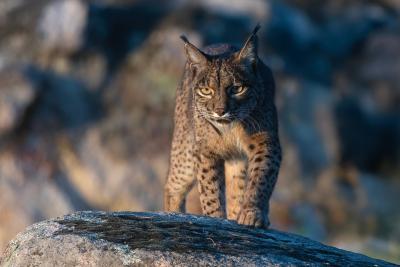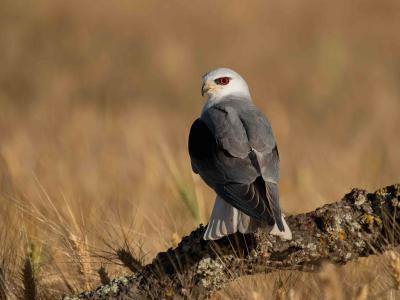Greece: Mainland Spring Migration
-
Apr 12-22, 2026
Oli Reville
-
Apr - May, 2027
Oli Reville
2026
Single Room Supplement $300
2027
Tour Price to be Determined
2026
Single Room Supplement $300
2027
Tour Price to be Determined
Greece is sandwiched between the countries of Albania, North Macedonia, and Bulgaria to the north, the Ionian Sea to the west, Turkey and the Aegean Sea to the east, and the Mediterranean Sea to the south. Its maritime location and varied landscapes not only helped shape Greece’s history and culture but are, along with its location on the eastern European migration flyway, key reasons for its diversity of birds. We’ll be in the field at the height of spring migration and should encounter many birds of prey, a wide variety of shorebirds at various wetland sites, and a host of passerines including wheatears, warblers, and shrikes, among many others. We’ll also pay attention to any reptiles, insects, amphibians, mammals, and flora that might catch our eye.
Day 1: We’ll begin in Bulgaria - there are a few birds there we can’t find in Greece - with an evening meal in Sofia, where we’ll go through the logistics of the tour. Night in Sofia.
Day 2: We’ll leave after breakfast and drive to the Sakar Mountains area in the south-eastern corner of Bulgaria. It’s a beautiful region with a wide range of habitats from deciduous forests to rolling grasslands, and depending on our arrival time, we may be able to begin birding this afternoon. Night near the Sakar Mountains.
Day 3: We’ll spend the day around the Sakar Mountains, coming to grips with many common birds, but focusing on highly prized species such as Black Stork, European Honey-buzzard, Short-toed Snake-Eagle, Lesser Spotted, Booted, and Imperial Eagles, Montagu’s Harrier, Long-legged Buzzard, Lesser Kestrel, Syrian Woodpecker, Calandra Lark, and Eastern Orphean Warbler. Night near Sakar Mountains.
Days 4-5: We’ll leave the Sakar Mountains on day 4 and head south, crossing into Northern Greece and on to the world famous Evros Delta. En route we’ll stop at Dadia Forest, one of Europe’s raptor-watching hotspots and home to the only breeding colony of Cinereous Vulture in the Balkan region. We may as well get views of Black Kite and White-tailed Eagle. We’ll spend the balance of the day in other parts of the Dadia-Lefkimi-Soufli National Park where a range of woodland and forest species can be found.
We’ll spend a day in the Evros Delta, on the Greek border with Turkey, and one of Europe’s largest wetlands. We’ll have special permits which grant us access to zones normally off limits. Spectacular birding is possible with thousands of shorebirds, waterfowl, gulls, and terns on offer, as well as Europe’s only stable breeding population of Spur-winged Lapwing. Impressive amounts of migratory and breeding shorebirds will include Spotted Redshank, Curlew Sandpiper, Kentish Plover, and Wood Sandpiper. Other key species for the area include Little Tern, Slender-billed Gull, Tawny Pipit, Greater Short-toed Lark, and much more.
Nights near Evros Delta.
Day 6: We’ll begin our journey west along the Aegean coastline towards Porto Lagos and the Delta Nestos National Park. En route we’ll stop near the village of Maroneia where the habitat is perfect for species such as Sardinian and Eastern Subalpine Warblers, Cirl Bunting, Eastern Black-eared Wheatear, Blue Rock Thrush, and Wood Lark. We’ll also search for the impressive Eurasian Eagle-Owl.
As we approach Porto Lagos we’ll stop at various birding locations. The coastal area near the Nestos River valley is home to a wide range of terns and gulls, including the elegant Slender-billed Gull. Night in Fanari.
Day 7: We’ll begin by exploring the south face of the Rhodopes Mountains along the Nestos River gorge. In this arresting location we’ll look for Sardinian Warbler, Woodlark, Northern Wheatear (of the localised Balkan subspecies), Crag Martin, and Griffon Vulture. We’ll also search for one of Europe’s most elusive and range-restricted birds, the Rock Partridge.
We’ll keep the itinerary flexible as we explore the coastline around Porto Lagos, a wonderful wetland landscape with flocks of shorebirds, gulls, and terns. Out to sea we may observe passing seabirds such as Yelkouan Shearwater, while in the lakes and shallow lagoons nearby, we should encounter groups of Greater Flamingo. We also stand a good chance of seeing Collared Pratincole. Night in Fanari.
Days 8-10: We’ll spend the morning of day 8 targeting any missing species around the Nestos Delta before heading towards Lake Kerkini. We’ll investigate wet areas close to the Strymonos River where Dalmatian and Great White Pelicans, all the European egrets and herons, Ferruginous Duck, and Black Stork can usually be found. We should also see multiple species of raptors, including Western Marsh Harrier and Lesser Spotted Eagle, along with passerines such as Eurasian Golden Oriole, Sardinian Warbler, Crested Lark, Spanish Sparrow, and Common Nightingale. In the wet woodlands which border parts of the lake we hope to come across Lesser Spotted and Grey-headed Woodpeckers.
We’ll take a boat trip on the lake where our experienced local guide will get us close to the pelican colony, giving us wonderful views and good photographic opportunities. We’ll also visit lakeshore riparian forests where we may find colonial waterbird breeders include Squacco Heron, Pygmy Cormorant, Little Egret, and Eurasian Spoonbill.
For a change of scenery, we’ll drive to Belles Mountain where a different range of species awaits including Sombre Tit, Cirl Buntings, Woodchat Shrike, and Hawfinch. We’ll also explore an old quarry where Blue Rock Thrush, Eastern Black-eared Wheatear, and Western Rock Nuthatch can usually be found.
Finally, we’ll also explore the habitats around the town of Siderocastro whose picturesque hillsides support the striking Eastern Subalpine Warbler, while the town itself holds populations of White Stork and Little Owl.
Participants who partake in optional pre breakfast walks should encounter Little Bittern, Penduline Tit, Great Reed Warbler, and, with luck, Little Crake, among others. Nights in Lake Kerkini.
Day 11: We will leave Lake Kerkini in the morning to head to Thessaloniki Airport where the tour will conclude.
WINGS Birding Tours © 2025
Note: The information presented below has been extracted from our formal General Information for this tour. It covers topics we feel potential registrants may wish to consider before booking space. The complete General Information for this tour will be sent to all tour registrants and of course supplemental information, if needed, is available from the WINGS office.
ENTERING BULGARIA and GREECE: United States citizens will need a passport valid for at least six months beyond your intended date of departure and with at least one blank page for an entry stamp. No visa is required for tourist visits of fewer than 90 days in a 180-day period.
Citizens of other nations should contact the nearest Greek and Bulgarian Consulates for entry requirements.
It is always a good idea to take photocopies of your passport and air ticket with you when traveling abroad. They can prove invaluable in helping you get replacements if your original documents are lost or stolen. You should pack the photocopies separately from the originals.
COUNTRY INFORMATION: You can review the U.S. Department of State Country Specific Travel Information here: https://travel.state.gov/content/travel.html. Review foreign travel advice from the UK government here: https://www.gov.uk/foreign-travel-advice and travel advice and advisories from the Government of Canada here: https://travel.gc.ca/travelling/advisories.
PACE OF TOUR: Some days will start with an optional pre-breakfast excursion which will last between one and two hours. After breakfast we will usually head out for the day. Some days we will spend one night in a hotel so please have your luggage ready to go with us after breakfast. Provided the weather is fine, we’ll have a picnic lunch. Some days we may return to the hotel for a break in the afternoon, but generally we’ll be out birding until about an hour before dinner, the time of which will vary depending on our itinerary.
The tour is not strenuous and is designed to be taken at a relaxed pace. However, in a couple of places we will walk on stony ground and up rocky valleys. Leisurely walks of up to 1 or 2km over easy terrain will be all that is required.
HEALTH: The most current information about travelers’ health recommendations can be found on the CDC’s Travel Health website at https://wwwnc.cdc.gov/travel/destinations/traveler/none/greece. You should contact your GP or local travel clinic to obtain the latest up to date advice. However, neither Bulgaria or Greece have any specific health issues and tap water is safe to drink.
Smoking: Smoking or vaping is prohibited in the vehicles or when the group is gathered for meals, checklists, etc. While in the field or traveling, use of a smokeless alternative such as nicotine gum is requested. Please do not smoke at short stops while traveling. If you smoke in the field, do so well away and downwind from the group and leave ample time between smoking and getting back into the vehicle. If you are sharing a room with a non-smoker, please do not smoke in the room. If any lodge, accommodation or location where the group is staying or is gathered has a more restrictive smoking policy than WINGS’ policy, the more restrictive policy will prevail. The leader reserves the right to modify this policy if the situation warrants it.
Miscellaneous: Insects shouldn’t be too much of a nuisance during our tour. It is worth checking yourself after walking in long grass in case of ticks.
CLIMATE: It is generally warm and pleasant in April with temperatures ranging between 17°C (62.6°F) and 23°C (73.4°F) in the daytime, but cooler in the early morning and evenings. The weather is usually stable during April but rain could occur.
ACCOMMODATION: Throughout the tour we will be staying at comfortable, good quality hotels. All rooms have a private bathroom with a shower. Hairdryers not provided, bring your own if you think you need one.
Internet and Mobile Phone Access: Our hotels have reasonably good Wi-Fi connection, and guests can use this on their own devices free of charge. Mobile phone access is very good throughout most of Greece.
FOOD: Most, if not all, evening meals will be taken at local tavernas serving good local Greek food. Lunch will either be at a taverna or more likely a picnic lunch provided by the leaders. Can you please bring a suitable plastic plate, cutlery and cup for the picnic lunches. There may also be some picnic breakfasts. Vegetarians are well catered for with a variety of vegetable dishes and salads.
WINGS tours are all-inclusive, and no refunds can be issued for any tour meals participants choose to skip.
Food Allergies/Requirements: We cannot guarantee that all food allergies can be accommodated at every destination. Participants with significant food allergies or special dietary requirements should bring appropriate foods with them for those times when their needs cannot be met. Announced mealtimes are always approximate depending on how the day unfolds. Participants who need to eat according to a fixed schedule should bring supplemental food. Please contact the WINGS office if you have any questions.
Drinks: At mealtimes we will provide water, and a choice of soft drink, a glass of local wine or a beer. We always keep a supply of bottled water on the tour vehicles.
TRANSPORTATION: Transportation will be in minibuses driven by the leaders or a larger bus with a driver if the group size requires it. The leader will arrange a seating rotation. Participants must be willing and able to ride in any seat in our tour vehicles.
2025 Narrative
Everyone gathered in Sofia, the capital of Bulgaria, where we met up with Minko Madjarov and began our drive south. While still in Bulgaria, we stopped at the 13th century monastery at Rila. Some of our first birds here included Crag Martins nest building in amongst the ancient structure, Song Thrushes, Coal Tits, Firecrest and Goldcrest in the surrounding woodland, and Red-rumped Swallows near our lunch spot. Other stops gave us mighty Griffon Vultures sailing overhead and brief views of Hawfinch.
Crossing the seamless border into Greece, we reached Lake Kerkini and its environs, our focus over the next few days. An early morning boat trip out onto the lake was an unforgettable experience as we found ourselves surrounded by hordes of Great White and Dalmatian Pelicans, and Great and Pygmy Cormorants, all busy either feeding or nesting. There were masses of Great Crested Grebes out on the open water and good numbers of Squacco, Grey and Purple Herons, and Little Egrets lining the shore. Coots and Moorhens crept through the reeds and a real highlight were the Little Crakes with a maximum of 5 different birds seen one day. The reed-fringed canals were the perfect place to see noisy Great Reed Warblers belting out their scratchy song, although Cettis Warbler and ubiquitous Nightingales competed for the loudest noise.
The shallow edges of the lake were perfect for shorebirds and we counted lots of Wood Sandpipers, together with Greenshank, Black winged Stilts, Pied Avocets, Common Sandpipers, a few Ruff, and best of all, dapper Spur-winged Plovers, a real rarity in this part of Greece. Raptors were plentiful with good numbers of both Marsh Harrier and Common Buzzard and by the time we had left we had added Golden and Booted Eagle, Montagu’s Harrier, Eurasian Sparrowhawk, Common Kestrel, Eurasian Hobby, Red-footed Falcon, and a massive adult White tailed Eagle to the raptor list. Add to all that some wonderful Greek taverna meals and Lake Kerkini really was the perfect start to our tour.
Leaving there to drive south, the day began with great views of Great Spotted Cuckoo by the hotel and ended on the beach near Farari watching Mediterranean and Slender -billed Gulls, Sandwich and Little Terns and a selection of waders including Eurasian Whimbrel and Eurasian Oystercatchers, while nearby woodland held Pied Flycatchers and a smart Wood Warbler. From our base we had access to a variety of habitats. The various coastal lagoons held flocks of Greater Flamingos and Shelduck, lots of Greenshanks and some Little Stints, with striking Yellow Wagtails of the Black-headed form around the margins. We had a single Parasitic Jaeger on the open sea, and the roadside wires, as well as being alive with Corn Buntings and numerous Common Kestrels, also provided perches for our first Woodchat Shrikes.
The beautiful, wooded slopes, wooded valleys and rocky outcrops of Nestos Gorge were buzzing with Eastern Subalpine Warblers along with lots of Cirl Buntings, Linnets, Eastern Orphean, Eastern Olivaceous and Sardinian Warblers, Woodlarks, and dapper Eastern Black-eared Wheatears. However, the honour of star bird must go to the pair of Rock Partridges we encountered. This is an elusive bird with a very restricted range and it took two visits to a high pass overlooking the gorge before we finally managed to get good views of a pair.
Heading East, we made a few visits to the open plains and wetlands where we watched Calandra Larks performing their song flight, and Little Gulls and a few Black Terns hawking for insects. As well as the ubiquitous Wood Sandpipers and Greenshanks, there was also a group of Spotted Redshanks and a fly-by Temminck’s Stint. The journey east continued and we spent time exploring the National Park at Dadia where Eastern Bonelli’s showed well.
The vast expanse of the Evros Delta provided lots of distractions. This mosaic of scattered lagoons, pools, canals, saltmarsh and reed beds produced a total of 21 shorebirds species. Highlights were the Spur-winged Plovers, the star shorebirds of the delta, and many thousands of Spotted Redshanks, many in smart coal-black breeding plumage. There were groups of Greenshank everywhere, hordes of Wood Sandpipers and Ruff, Black-tailed Godwits, several Little Stints and a single Temminck’s Stint, a couple of Red Knot and many flocks of Collared Pratincoles hawking insects overhead. It was great to see an almost constant procession of migrating groups of Little Gulls heading inland, most in full breeding plumage. Away from the water Greater Short-toed Larks joined the Skylarks and more Calandra Larks as we drove in, Yellow Wagtail became common and we found several aptly named Tawny Pipits, as well as catching up with Penduline Tit, sight of which had evaded us so far. As we approached the end of the tour our final stop was in the town of Komotini. Here we explored quiet valleys and grassy hillsides where migration was obvious as we found the smart male Red-backed Shrikes, up to 25 blue Eurasian Rollers in one day, some hard-to-see Golden Orioles, a pair of fluffy Eurasian Eagle Owl chicks in a nest, and a cracking male Masked Shrike.
The long drive back to Sofia was broken with some birding in Bulgaria once we sailed through the border and the new birds kept coming. We found Lesser Grey Shrike, one of the last migrants to arrive, a pair of Rollers at a nest site, a fine Barred Warbler that sat up for us, and a cute Lesser Spotted Woodpecker which showed really well. We ended the tour back where we had started in Sofia with a fine meal at one of the oldest restaurants in the city.
- Steve Rooke
This tour is limited to 10 participants with two leaders.

























